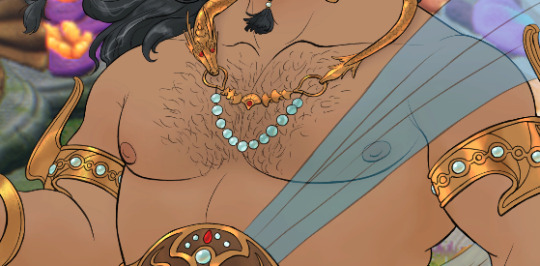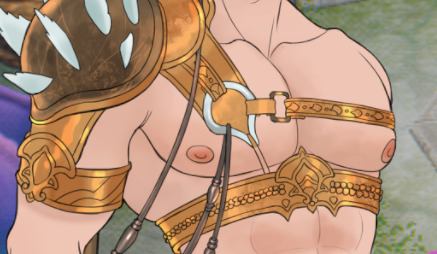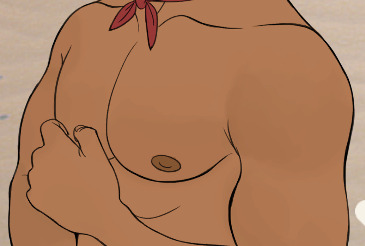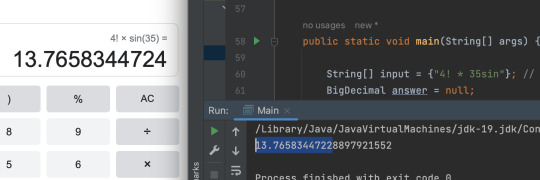#krakatoa
Explore tagged Tumblr posts
Text

"Cargo Handoff" by Lauren Herda
106 notes
·
View notes
Text
// talking about nipples //
Theory but Agung is one of the few characters out there that might have inverted nipples!
Yes, I did looked a lot of the other characters' nipples because I was curious.
Yes, he is not the only one, but the only merfolk to have inverted nipples.
Yes, the other land-dwelling inverted nipple-er is Ben.
Case in point:



Comparing King Krakatoa's and Semeru's nipples, we can see that their nipples are protruding based on the lines drawn in their nipples. The game is IMMACULATE in their details, and I don't believe this is the case of artists forgetting to draw the line.




On another note, we can also see how Ben's nipples (picture on the bottom right) doesn't have the same line as Surya's and Kenny's (respectively, on the top left and top right) nipples, which perhaps indicative that Ben's nipples are in fact inverted.
That being said, I also noticed that Pablo's nipples are drawn differently than others, and may perhaps show that his nipples are flat.
#coral island#agung#krakatoa#semeru#surya#kenny#pablo#ben#i'm sleep deprived#also this has been bugging me#so i need to write something about it#and here is my piece!!!
36 notes
·
View notes
Text

On this day:
KRAKATOA PROPHECY
On August 29, 1883, Edward Samson, a reporter for the Boston Globe, awoke drenched with sweat from a terrifying dream. He was lying on the couch in his office, where he had fallen asleep. It was 3 a.m. as he frantically scribbled down the details of his horrific dream: A catastrophic volcano had destroyed the tiny Indian Ocean island of Pralape. Extreme terror gripped the natives as they were trapped between the rivers of red-hot lava and the boiling ocean. Walls of mud flowed fifty feet high, and ships were crushed between gargantuan waves. The island exploded in an earth-shattering blast and disappeared beneath the waves, leaving only a "fire-spouting crater in the foaming sea." Samson left the written account of his dream on his desk, with "important" written across the top of the paper.
It was found the next morning by the Boston Globe's editor. He ran the story with a banner headline across the entire front page. He then passed the information onto other newspapers. When it was discovered that the article was based on Samson's dream, he was fired. Before retractions could be made, however, random reports of disaster began to come in. The greatest sea wave ever circled the earth, and an atmospheric wave went round three times. Communities in Malaya and India were destroyed by tidal waves. The explosion of Krakatoa was reported. Samson was back on staff.
Samson's dream had happened at the actual time the events occurred. The only incongruence was the name of the island. The mystery was cleared up when Samson was much older. The Dutch Historical Society sent him an old map of the Indian Ocean, and on it, Krakatoa was called by its native name of one hundred and fifty years earlier: Pralape.
Text from: Almanac of the Infamous, the Incredible, and the Ignored by Juanita Rose Violins, published by Weiser Books, 2009
13 notes
·
View notes
Text
Adelheid spots Claudius crying over a Pompeii documentary and Emma trying to support him. Claudius tells her about the 79ad mount Vesuvius eruption as seen in the documentary. He saw people running in fear and getting killed by the volcano. Curious Adelheid ask Emma to see the eruption in the documentary. When she saw the CGI rendering of the cloud rising above Vesuvius, it reminded her of seeing photos of an erupting Krakatoa in the news papers when she was alive.(the press pack as seen in @german-ghosts says she died in 1890 in her 60s. Krakatoa eruption happened in 1883.) She remembered reading about the survivor accounts of black skies, raining ash and dark avalanches and the Pompeii documentary shows scenes like this. She tells Claudius that she experienced the same feelings as him when she learned about Krakatoa. What also helped him is that people were still rediscovering Pompeii both in Emma’s and Adelheid’s time.
#adelheid von donnerhall#die geister#ard ghosts#wdr ghosts#krakatoa#pompeii#volcano#claudius#Emma küper
4 notes
·
View notes
Text

The mighty volcano of Krakatoa, which devastated around Sunda strait with a tremendous tsunami, and also affected the rest of the world from its ash clouds, which creates another year without summer in Europe after Tambora eruption.
50 notes
·
View notes
Text


Happy 73rd birthday to Rodger Bumpass, the voice of Squidward from SpongeBob
2 notes
·
View notes
Text

Though there isn’t an exact way to prove it, historians and geographers reckon that the explosion of the Krakatoa volcano in 1883 was the loudest noise ever heard on planet Earth. People heard the eruption from over 3000 miles away.
The eruption was so huge that it destroyed much of the island that the volcano was situated on. It also killed tens of thousands of people that were living on the nearby islands. But the Krakatoa volcano is still there, and still active to this day.
4 notes
·
View notes
Video
Mount Bromo by Richard Walker Via Flickr: This wonderful shot of Mount Bromo in Indonesia taken by my late son Chris J Walker, sound recordist, while working on the Krakatoa film for Channel 4 TV (Chris J Walker 06.03.74 - 08.01.05)
19 notes
·
View notes
Text



















Ramon Tikaram as Tokaya in Krakatoa: The Last Days (2006)
#ramon tikaram#krakatoa#krakatoa the last days#gif#ramon spoke some indonesian here#i rly liked this movie/doc#so sad
13 notes
·
View notes
Text

>:(((((((((
#krakatoa#Bean counter#my Taylor series expansion for the sine calculation currently uses 7 terms#not that the last three terms have made any difference at all#javajavajavajavajavajavajava#to the surprise of no one ever adding an 8th term also did not make a difference#sorry I no know one here is interested in this and or it makes sense to no one#my academics friends have been doing a lot of smiling and nodding recently
7 notes
·
View notes
Text
Krakatoa explodes
One of the most powerful volcanic eruptions in recorded history occurs on Krakatoa (also called Krakatau), a small, uninhabited volcanic island east of Sumatra and west of Java, on August 27, 1883. Heard 3,000 miles away, the explosions threw five cubic miles of earth 50 miles into the air, created 120-foot tsunamis and killed 36,000 people.
Krakatoa exhibited its first stirrings in more than 200 years on May 20, 1883. A German warship passing by reported a seven-mile high cloud of ash and dust over Krakatoa. For the next two months, similar explosions would be witnessed by commercial liners and natives on nearby Java and Sumatra. With little to no idea of the impending catastrophe, the local inhabitants greeted the volcanic activity with festive excitement.
On August 26 and August 27, excitement turned to horror as Krakatoa literally blew itself apart, setting off a chain of natural disasters that would be felt around the world for years to come. An enormous blast on the afternoon of August 26 destroyed the northern two-thirds of the island; as it plunged into the Sunda Strait, between the Java Sea and Indian Ocean, the gushing mountain generated a series of pyroclastic flows (fast-moving fluid bodies of molten gas, ash and rock) and monstrous tsunamis that swept over nearby coastlines. Four more eruptions beginning at 5:30 a.m. the following day proved cataclysmic. The explosions could be heard as far as 3,000 miles away, and ash was propelled to a height of 50 miles. Fine dust from the explosion drifted around the earth, causing spectacular sunsets and forming an atmospheric veil that lowered temperatures worldwide by several degrees.
Of the estimated 36,000 deaths resulting from the eruption, at least 31,000 were caused by the tsunamis created when much of the island fell into the water. The greatest of these waves measured 120 feet high, and washed over nearby islands, stripping away vegetation and carrying people out to sea. Another 4,500 people were scorched to death from the pyroclastic flows that rolled over the sea, stretching as far as 40 miles, according to some sources.
In addition to Krakatoa, which is still active, Indonesia has another 130 active volcanoes, the most of any country in the world.
3 notes
·
View notes
Text

Interesting
Today in History: Aug 26, 1883 – The 1883 #eruption of #Krakatoa begins its final, paroxysmal, stage.
(https://en.wikipedia.org/wiki/1883_eruption_of_Krakatoa)
*In 2003, an astronomer proposed the idea that the blood-red sky shown in Edvard Munch’s famous 1893 painting The Scream is also an accurate depiction of the sky over Norway after the eruption.
(http://www.skyandtelescope.com/press-releases/astronomical-sleuths-link-krakatoa-to-edvard-munchs-painting-the-scream/)
2 notes
·
View notes
Text
youtube
Sorry
4 notes
·
View notes




